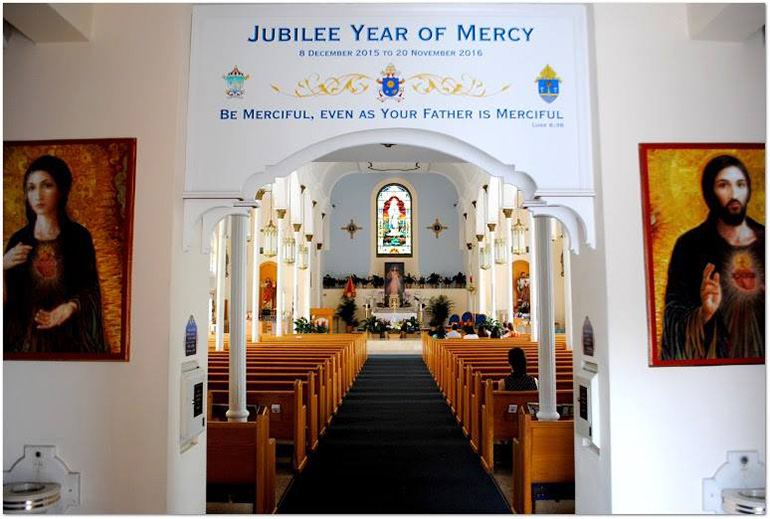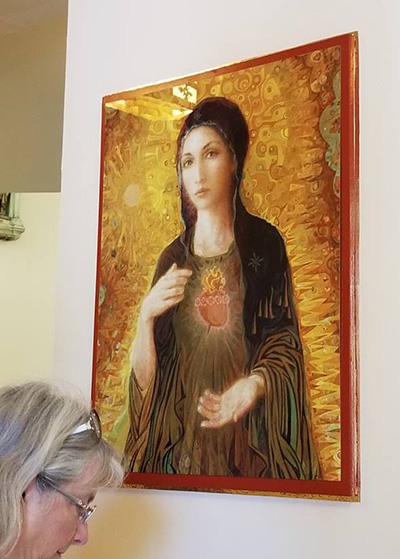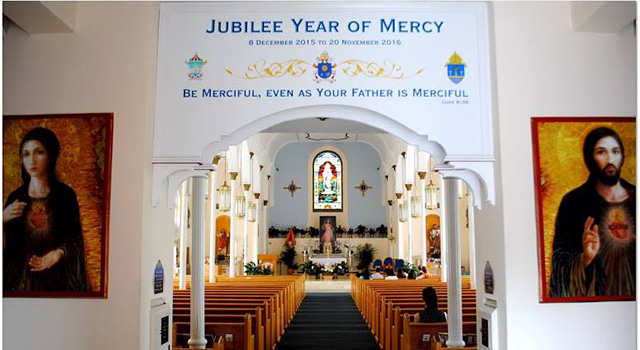By Blanca Morales - Florida Catholic

Photographer: BLANCA MORALES | FC
Cameron Smith's work, Two Hearts, adorns this entrance to the Basilica of St. Mary Star of the Sea in Key West.
MIAMI | Cameron Smith officially became an artist just before he graduated from North Carolina State College of Design in 1994. A few years later, a message from John Paul II to artists inspired him to express his faith through art.
Smith found a deep, spiritual purpose in the practice of art. Though trained in design school in a variety of disciplines, he taught himself oil painting. His work combines traditional aspects of iconography with contemporary style. This can be seen in his most popular work, “Two Hearts,” featuring the Sacred and Immaculate Hearts. A print of “Two Hearts” currently welcomes visitors to the Basilica of Mary Star of the Sea in Key West.
His work combines a variety of styles � impressionism, realism, graphic design, and abstract � within a single canvas. “This is something that I am particularly interested in and which has been enthusiastically received,” Smith said.
In the following interview, Smith shares with the Florida Catholic about the journey of Catholic art in contemporary times.
What inspires you as an artist?
Smith: I started out keenly interested in the person as a subject. Figures and portraits captivated me. This led me to portraiture and commissioned work.
What are some of the challenges of being a Catholic artist
Being a Catholic artist is quite a journey. I’ve found my spirituality and artistic growth to be on parallel courses. In the context of JPII’s Letter to Artists (a must read), it’s kind of spooky, so to speak. The laity is very receptive and appreciative of good work, and this can be deeply rewarding and confirming. Because there are almost no economic resources available, artists should not give up their day jobs and always look for ways to meet the needs of the people and invent new income streams. This can be a difficult challenge, as one must stay ever mindful that beauty, not profit, is the objective, as JPII clearly states. So it’s a journey � a struggle � to balance survival with the idealistic quest for beauty.
How does your artistic vision of blending different styles come together?
As long as hierarchy, balance, visual interest and common sense are achieved, it works and doesn’t need to look contrived or out of context. It first came together in a religious context, with the Immaculate Heart of Mary, which was my version of a contemporary icon. Icons traditionally incorporate modeled, dimensional figure elements with flat, graphic, and patterned backgrounds. This was the initial concept. It just kept resurfacing in other ways and is now pervading my work, influencing all subjects.

Photographer: COURTESY
Artist Cameron Smith's "culturally correct" image of the Immaculate Heart of Mary is seen here at the entrance to the Basilica of St. Mary Star of the Sea in Key West.
Where can we see some of your work?
I’ve done a fair amount of commissioned original work for churches and shrines. One of my favorites was St. Maron for the Our Lady of Lebanon chapel at the Basilica of the National Shrine of the Immaculate Conception. A few others include a portrait of John Paul II for St. Stans in New York, the Sacred and Immaculate Hearts for Our Lady of Mount Carmel in San Diego, and over a dozen other works including saints and architectural subjects.
But you also sell prints of some of your work. How have those been received?
Several non-profit organizations, schools, religious orders, Relevant Radio, EWTN, and at least three dioceses have asked to use images for ordinations, consecrations, and other purposes. I know of a few churches displaying the images of the Two Hearts. Our Lady’s image has even been popular with non-Catholics and has been used without permission in several instances. Maybe Our Lady has a purpose in this. I can only hope!
The image of the Two Hearts has been observed to be “culturally correct.” Was this on purpose?
My intention is always to paint Our Lord and Our Lady with respect to their Jewish lineage, the chosen race. I feel an obligation � it’s just too prevalent a scriptural reality. I wouldn’t argue with other interpretations, as I believe visionaries may see Our Lady, for example, in their own race. This extends to dress and manner, as we clearly see Our Lady of Guadalupe appearing in the dress and manner of the Aztec culture to which she first appeared. My rendition of Our Lady of Guadalupe does not remain strictly within this context, as I wish to ‘re-present’ her to our contemporary culture. Many people miss the message of Our Lady of Guadalupe because they don’t get all the coded symbols of the Tilma’s image. That said, I don’t wish to deviate wildly from traditional images of the Two Hearts or the original Tilma. I use them extensively as sources for my own images. I only wish to ‘speak’ in the visual ‘vernacular’ of our time, because that is what reaches people.
What are your thoughts on art in the Church today?
Language, visual styles, musical styles all constantly evolve. At times we may not like it. It can often even be a devolution. Despite this, relevancy is important, so the artist must find the beauty within new styles and contexts.
This is a difficult and confusing time for the Church regarding visual arts. In theory, the Church is very supportive of beauty and art, but experts on beauty in visual art do not abound. Visual art departments at Catholic universities are uncommon as well as diocesan “art director” positions. A dominant culture of aesthetic relativism over the past century left a wake of artistic confusion. The Church tends to not promote something unless confident of its beauty, truth, or goodness, so it hasn’t been promoting much new art.
Do you believe parishes are making an effort in visually displaying beauty, goodness and truth?
The Church is just starting to recover from an architectural period which all but disowned sacred art. Now many are resorting to catalogue art, reproductions, and faux traditional architecture as an attempt to improve, and because it’s readily available. Well-meaning, [but] this is also problematic. The Church doesn’t allow silk flowers, for example, only the real ones. This is the concept of integrity. When applied to art and architecture, integrity [shouldn’t] allow reproductions or fake columns either. But this understanding could take a while to work through political channels.
How can we move toward an integrated approach to beauty in the Church today?
I personally believe a solid systematic teaching of objective beauty could help and am currently working on this project. Another very promising sign is the development of many grassroots initiatives and “.orgs” embracing promotion of the sacred arts. JP2 Arts (jp2arts.org), for example, is providing a working grant for “Our Lady of Guadalupe.” I would not otherwise be able to do the piece. I’ve seen several initiatives, competitions, and even talk of investment or collector resources to connect artists and investors. This could be powerful, especially considering how vigorous the contemporary art markets are. Perhaps there’s a sleeping giant.
If you would like to see Smith’s work, visit www.studiocameronsmith.com or https://www.facebook.com/smithcatholicart/

